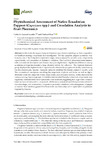Mostrar o rexistro simple do ítem
Phytochemical Assessment of Native Ecuadorian Peppers (Capsicum spp.) and Correlation Analysis to Fruit Phenomics
| dc.contributor.author | García-González, Carlos-Alberto | |
| dc.contributor.author | Silvar, Cristina | |
| dc.date.accessioned | 2020-10-06T08:14:09Z | |
| dc.date.available | 2020-10-06T08:14:09Z | |
| dc.date.issued | 2020-08-04 | |
| dc.identifier.citation | García-González, C.A.; Silvar, C. Phytochemical Assessment of Native Ecuadorian Peppers (Capsicum spp.) and Correlation Analysis to Fruit Phenomics. Plants 2020, 9, 986. https://doi.org/10.3390/plants9080986 | es_ES |
| dc.identifier.issn | 2223-7747 | |
| dc.identifier.uri | http://hdl.handle.net/2183/26346 | |
| dc.description.abstract | [Abstract] In this work, the impact of pepper (Capsicum spp.) fruits morphology on their composition for health-promoting compounds was investigated. For that purpose, pepper accessions from Ecuador, one of the hotspots in Capsicum’s origin, were analyzed for ascorbic acid, polyphenols, capsaicinoids, and prevention of cholesterol oxidation. Plant and fruit phenomics were assessed with conventional descriptors and Tomato Analyzer digital traits. Significant differences among accessions and species revealed a large diversity within the collection. The Capsicum frutescens group displayed the highest levels of capsaicinoids, whereas the polyphenols shortly varied among the five domesticated species. Capsicum pubescens exhibited the lowest content of ascorbic acid. The conventional descriptors describing the magnitude of plants and fruits, as well as digital attributes under the categories of size, shape index, and latitudinal section, mostly explained the variance among Capsicum groups. Correlation test revealed that phytochemical components were negatively correlated with the morphometric fruit attributes, suggesting that huge fruits contained lower amounts of nutraceutical compounds. Multivariate analysis showed that parameters related to fruit size, shape, and nutraceutical composition primarily contribute to the arrangement of pepper accessions. Such results suggested that those traits have been subjected to higher selection pressures imposed by humans. | es_ES |
| dc.description.sponsorship | This research was funded by Spanish Institute for Agricultural and Food Research and Technology (INIA), co–financed by the European Regional Development Fund (FEDER) (Project RTA2015-00042-C02-02), and by Xunta de Galicia (Project ED431C 2018/57) | es_ES |
| dc.description.sponsorship | Xunta de Galicia; ED431C 2018/57 | es_ES |
| dc.language.iso | eng | es_ES |
| dc.publisher | MDPI | es_ES |
| dc.relation | info:eu-repo/grantAgreement/MINECO/Plan Estatal de Investigación Científica y Técnica y de Innovación 2013-2016/RTA2015-00042-C02-02/ES/APLICACIÓN DE HERRAMIENTAS GENÓMICAS Y METABOLÓMICAS PARA EL ESTUDIO DEL CARÁCTER PUNGENTE EN PIMIENTO Y CEBOLLA/ | |
| dc.relation.uri | https://doi.org/10.3390/plants9080986 | es_ES |
| dc.rights | Atribución 4.0 Internacional | es_ES |
| dc.rights.uri | http://creativecommons.org/licenses/by/4.0/ | * |
| dc.subject | Nutraceutical compounds | es_ES |
| dc.subject | Capsaicinoids | es_ES |
| dc.subject | Ascorbic acid | es_ES |
| dc.subject | Polyphenols | es_ES |
| dc.subject | Tomato Analyzer | es_ES |
| dc.subject | Conventional phenotyping | es_ES |
| dc.subject | Correlation analysis | es_ES |
| dc.title | Phytochemical Assessment of Native Ecuadorian Peppers (Capsicum spp.) and Correlation Analysis to Fruit Phenomics | es_ES |
| dc.type | info:eu-repo/semantics/article | es_ES |
| dc.rights.access | info:eu-repo/semantics/openAccess | es_ES |
| UDC.journalTitle | Plants | es_ES |
| UDC.volume | 9 | es_ES |
| UDC.issue | 8 | es_ES |
| UDC.startPage | 986 | es_ES |
| dc.identifier.doi | 10.3390/plants9080986 |
Ficheiros no ítem
Este ítem aparece na(s) seguinte(s) colección(s)
-
GI-GIBE - Artigos [75]






